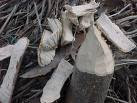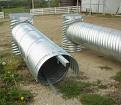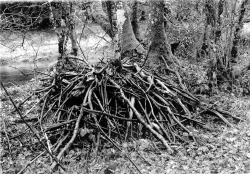Dear Bill & Kate, Nov. 6th 2007
May we ask that you think carefully before endorsing so wholeheartedly the return of beaver to the wild in Britain? Here in Argyll we are in one of the proposed trial areas and we had hoped that you, as people who care about the countryside, would help us oppose the scheme.
For everything moving into any area, something else has to move out. Our lochans here in North Knapdale have a balanced eco-system, perfected over at least 400 years without beaver. The introduction of new mammals requiring a considerable quantity of vegetation every day would mean that the 50m wide edging to the waterside would cease to support the small animals, insects, and therefore bird life it does at present. It only takes a beaver a matter of minutes to fell a sapling that has taken ten years to grow – during which time the tree has helped support the lives of countless other organisms. And when that sapling is gone nothing will replace it.
At the moment one of the lochans has a rare water lily, called the Least Water-lily (Nuphar Pumila). It features in the life cycle of the dragonflies for which the lochan is famous. But beaver are particularly fond of water lily, so that would be eaten pretty quickly – exit the dragonflies from the lochan.
If there were to be just one group of beaver it might be manageable, but the proposal here is to introduce up to 20, and the delightful kits of these families, as seen in your programme last night, grow up and at the age of two or three, move away and have kits of their own. In time, with appropriate sites being limited to glens with water, they would get into far less suitable places and because of the damage they have to cause by the very nature of their way of life, many would end up being killed. Is this really such a good idea?
People coming to an area expecting to see the beaver would often be disappointed because, as you said, the animals are primarily nocturnal. But that wouldn’t stop visitors attempting to get close, and in order to stop potentially dangerous situations arising, the areas where the beavers were would have to be fenced; CCTV cameras and viewing huts are already being discussed. How does this help wildlife?
As a species beaver is under no threat, in Europe there are literally hundreds of thousands of them. But the Scottish Wild Cat is down to such small numbers as to be barely viable; the Black Grouse has almost disappeared from this area and in the last two years tern colonies on our small islands in the Tayvallich bay have been completely exterminated by introduced (albeit accidentally) mink. Any of these problems would benefit enormously from the proposed half a million pounds which is proposed to be spent on the introduction of a destructive species.
Please be brave enough to mention these facts on your programme, not just the cuddly aspect of these animals. Please look at our blogsite: http://beaverboycott.blogspot.com/ for thoughts and experiences of people who would prefer beaver not to be introduced here. Thank you.
Tuesday, 6 November 2007
Subscribe to:
Post Comments (Atom)









7 comments:
Bravo, I am delighted that you are watching beavers and so supportive of their return to England and Scotland.
Several comments are worth making about some of the information on your blog.
1. Beavers eat between one and two kilos a day (Muller-Schwarze and Lixing Sun, 2003).
2. Beavers have teeth and bite, but bite humans only when being handled carelessly. They are unagressive, except in defence of their kits or fearful of being attacked.
The photograph entitled 'Coming soon this could be a loch near you' looks to me like a clear fell of a coniferous forest, carried out by humans and has nothing to do with beavers.
The photograph captioned 'Beaver Tree Damage' - if it is willow or birch in the wild the trees will coppice abundantly. Most of the hardwoods native to the British Isles coppice or sucker to a greater or lesser extent.
The effect of beavers on riparian woodland can be to thicken it up and create a low scrubby forest. I have seen this on the River Gard, a tributary of the Rhone in France.
It is worth remembering that beavers seldom go further than fifty metres from the water's edge and, in fact, most of their time is spent within five metres of the water.
If the tree in your photograph was in someone's garden the owner would be justifiably upset. With warning simple beaver proof guards can be put up to protect trees. On the other hand there might be a case for compensation. I unnderstand that these questions are being discussed at the moment.
The beaver dam in Black Hill Regional Park, illustrated in your photograph, is doing a fine job.
It is filtering water, leaving the purified water to flow on down.
It is providing habitat for plants, an abundance of invertebrates, fish, amphibians and mammals.
Not only that, but the dam is holding back water that might be part of a flood if it were a season of snow melt or heavy rainfall. In time of drought the dam is retaining water in a parched landscape.
What more can I say?
Welcome the beaver, people of Argyll!
Beavers may grow to be 70 lbs (32 kg), but the average is more like 40lbs (18kg).
It is true that you would make a mess of your car if you ran into one, but the likelihood of doing so in the next twenty years is rather small.
Besides, the scale of road kill in this country, as in others, is a disgraceful demonstration of our lack of concern for our fellow creatures - deer, badgers, foxes, red squirrels, otters - on and on they go because we drive too fast.
Yes, correctly.
Post a Comment